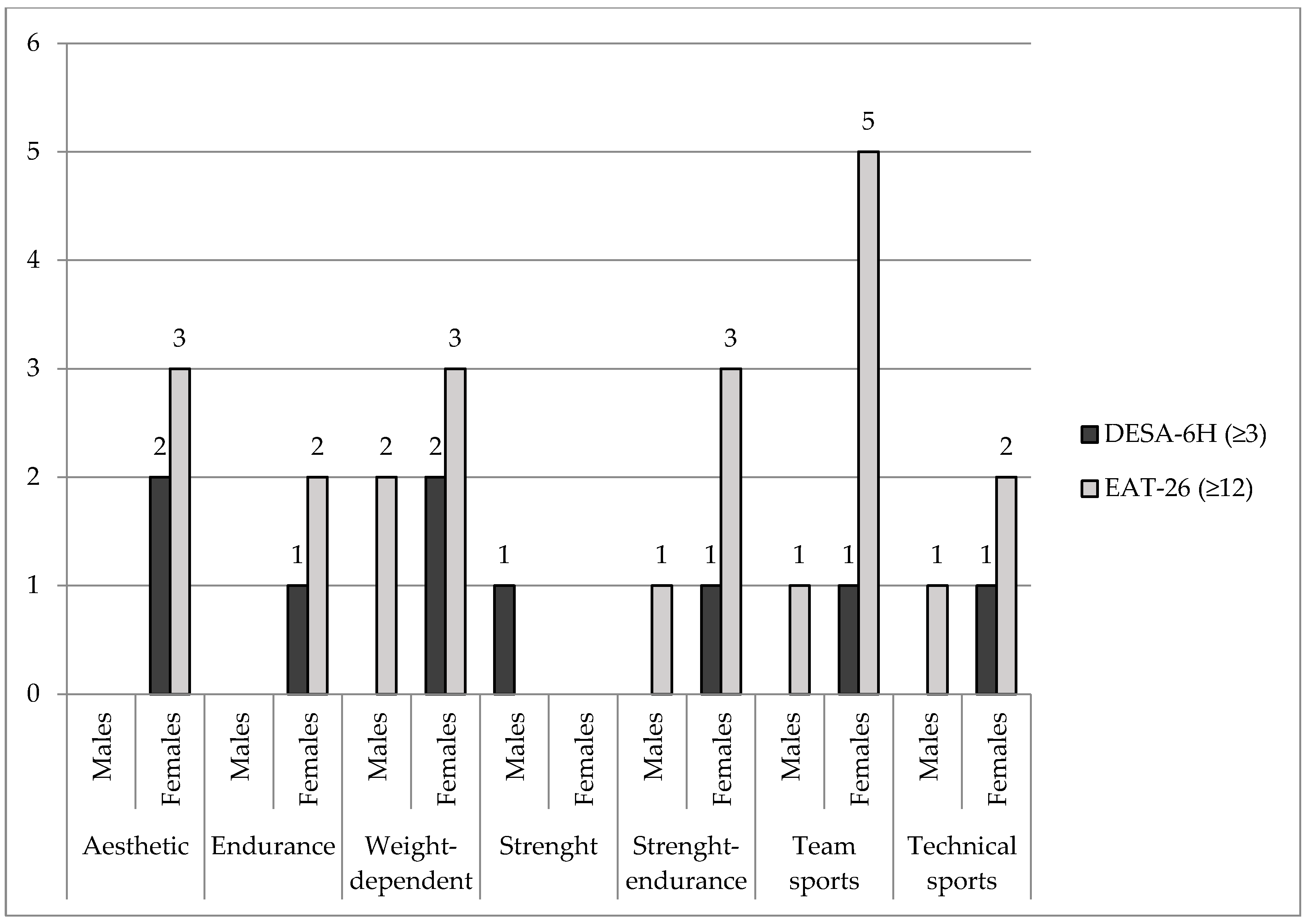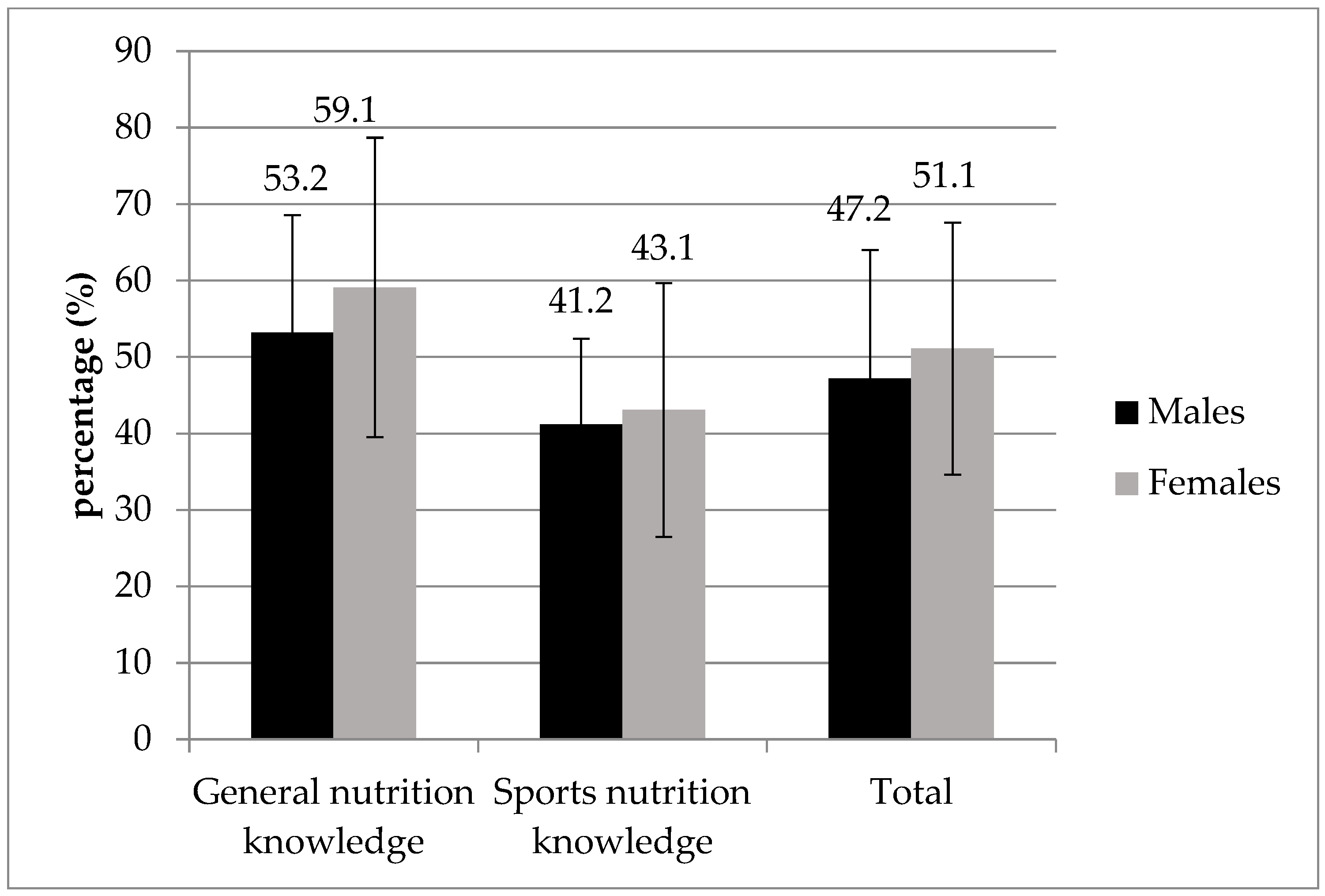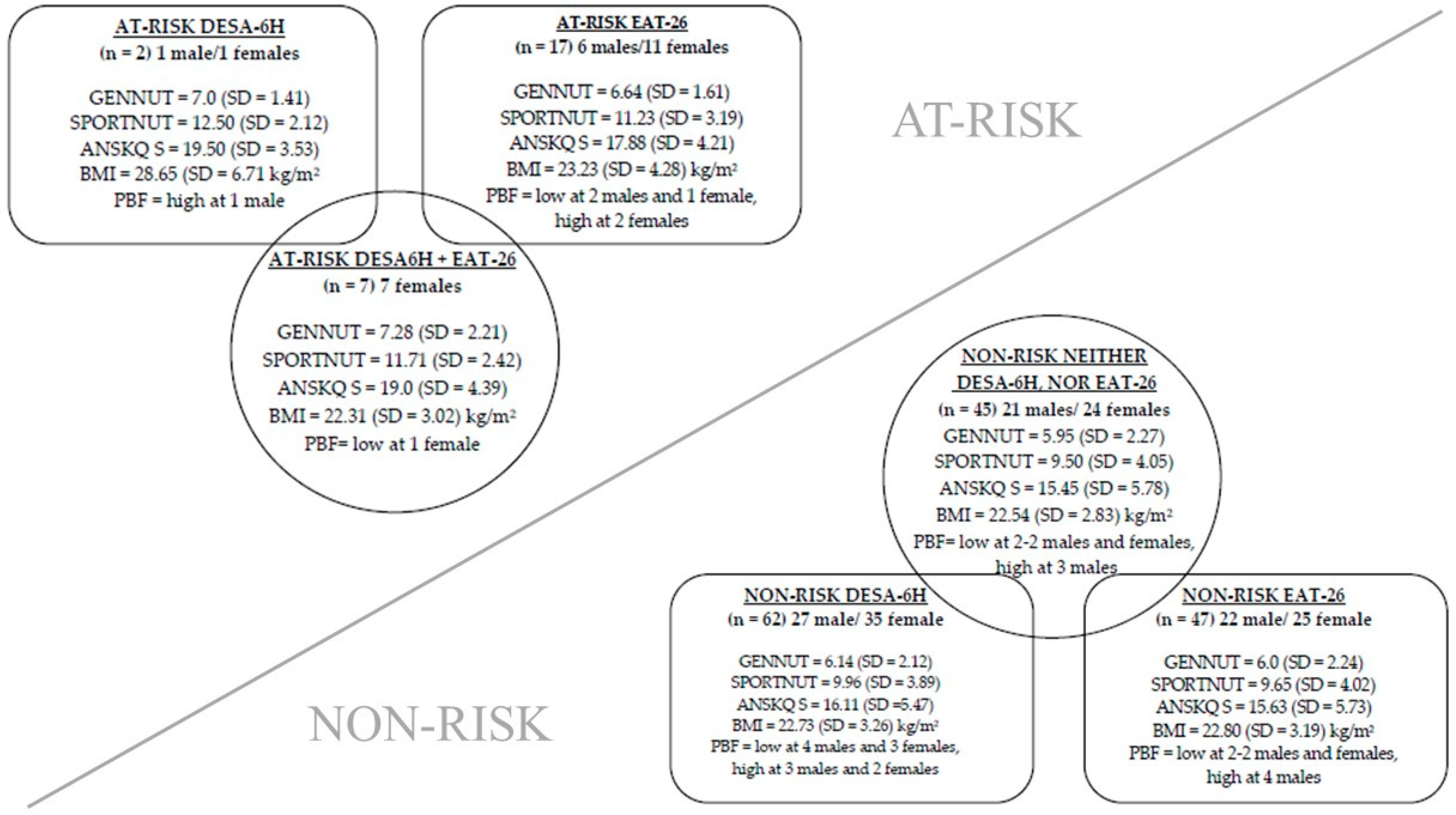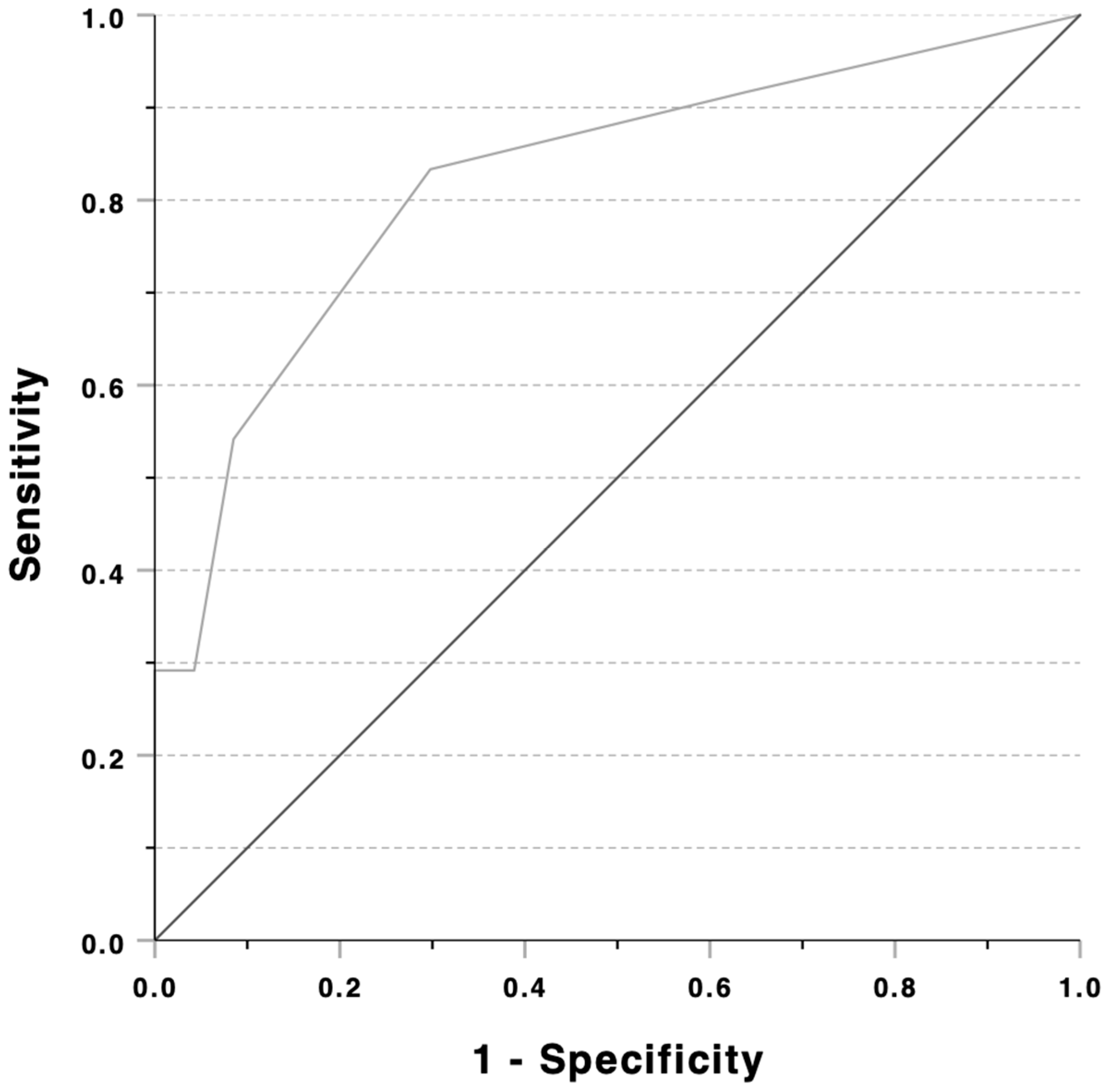Balancing Performance and Health in Elite Hungarian Athletes: The Relationship Among Disordered Eating Risk, Body Composition, and Nutrition Knowledge
Abstract
1. Introduction
2. Materials and Methods
2.1. Study Design
2.2. Data Collection
2.3. Measures
2.3.1. DESA-6—Disordered Eating Screen for Athletes
2.3.2. EAT-26—Eating Attitudes Test
2.3.3. A-NSKQ—Abridged Nutrition for Sport Knowledge Questionnaire
2.4. Ethical Considerations
2.5. Data Analysis
3. Results
3.1. DESA-6H and EAT-26 Scores
3.2. Body Composition
3.3. Nutrition Knowledge
3.4. Relationship Among Disordered Eating Risk, Body Composition, and Nutrition Knowledge
3.5. Differences Across Gender and Nutritional Status in Disordered Eating Risk and Eating Attitudes
3.6. Differences Across At-Risk and Non-Risk Groups Based on DESA-6H and EAT-26 Scores in Nutrition Knowledge
3.7. At-Risk and Non-Risk Athlete Profiles
3.8. The Diagnostic Accuracy of DESA-6H to Separate DE Risk Groups
4. Discussion
4.1. At-Risk Athletes Across Gender and Sport Disciplines
4.2. Body Composition of Athletes
4.3. Nutrition Knowledge of Athletes
4.4. Comparative Sensitivity of DESA-6 and EAT-26 in Detecting Disordered Eating Risk
4.5. Limitations and Future Directions
5. Conclusions
Author Contributions
Funding
Institutional Review Board Statement
Informed Consent Statement
Data Availability Statement
Conflicts of Interest
Abbreviations
| AUC | Area under the curve |
| DE | Disordered eating |
| ED | Eating disorder |
| EDI | Eating Disorder Inventory |
| DSM-V | Diagnostic and statistical manual of mental disorders |
| BN | Bulimia nervosa |
| BED | Binge eating disorder |
| BDD | Body dysmorphic disorder |
| LEA | Low energy availability |
| BF | Body fat |
| IC | Internal consistency |
| A-NSKQ | Abridged nutrition for sport knowledge questionnaire |
| KR-20 | Kuder–Richardson formula 20 |
| DESA-6 | Disordered Eating Screen for Athletes |
| EAT-26 | Eating Attitude Test |
| BMI | Body Mass Index |
| DESA-6H | Disordered Eating Screen for Athletes—Hungarian version |
| IOC | International Olympic Committee |
| APA | American Psychiatric Association |
| PBF | Percent body fat |
| NSKQ | Nutrition for Sport Knowledge Questionnaire |
| WHO | World Health Organization |
| ACE | American Council of Exercise |
| EAT-26 | S EAT-26 total score |
| EAT-26 | D EAT-26 dieting behavior subscale |
| EAT-26 | O EAT-26 oral control subscale |
| EAT-26 | B EAT-26 bulimia and food preoccupation subscale |
| GENNUT | General nutrition knowledge |
| ROC | Receiver operating characteristic |
| SPORTNUT | Sport nutrition knowledge |
| ANSKQ S | A-NSKQ total score |
References
- Jeukendrup, A.E. Periodized Nutrition for Athletes. Sports Med. 2017, 47, 51–63. [Google Scholar] [CrossRef] [PubMed]
- Holtzman, B.; Ackerman, K.E. Recommendations and Nutritional Considerations for Female Athletes: Health and Performance. Sports Med. 2021, 51, 43–57. [Google Scholar] [CrossRef]
- Burke, L.M.; Phillips, S.M.; Shirreffs, S.M.; Loucks, A.B.; Jeukendrup, A.E. IOC consensus statement on sports nutrition 2010. J. Sport Sci. 2011, 29 (Suppl. S1), S3–S4. [Google Scholar] [CrossRef]
- Kerksick, C.M.; Arent, S.; Schoenfeld, B.J.; Stout, J.R.; Campbell, B.; Wilborn, C.D.; Taylor, L.; Kalman, D.; Smith-Ryan, A.E.; Kreider, R.B.; et al. International society of sports nutrition position stand: Nutrient timing. J. Int. Soc. Sports Nutr. 2017, 14, 33. [Google Scholar] [CrossRef] [PubMed]
- Reardon, C.L.; Hainline, B.; Aron, C.M.; Baron, D.; Baum, A.L.; Bindra, A.; Budgett, R.; Campriani, N.; Castaldelli-Maia, J.M.; Currie, A.; et al. Mental health in elite athletes: International Olympic Committee consensus statement. Br. J. Sports Med. 2019, 53, 667–699. [Google Scholar] [CrossRef] [PubMed]
- Danaher, K.; Curley, T. Nutrition Knowledge and Practices of Varsity Coaches at a Canadian University. Can. J. Diet. Pract. Res. 2014, 75, 210–213. [Google Scholar] [CrossRef] [PubMed]
- Martinsen, M.; Sundgot-Borgen, J. Higher Prevalence of Eating Disorders among Adolescent Elite Athletes than Controls. Med. Sci. Sports Exerc. 2013, 45, 1188–1197. [Google Scholar] [CrossRef] [PubMed]
- Mancine, R.P.; Gusfa, D.W.; Moshrefi, A.; Kennedy, S.F. Prevalence of disordered eating in athletes categorized by emphasis on leanness and activity type—A systematic review. J. Eat. Disord. 2020, 8, 47. [Google Scholar] [CrossRef]
- Karlson, K.A.; Becker, C.B.; Merkur, A. Prevalence of eating disordered behavior in collegiate lightweight women rowers and distance runners. Clin. J. Sports Med. 2001, 11, 32–37. [Google Scholar] [CrossRef]
- Kampouri, D.; Kotopoulea-Nikolaidi, M.; Daskou, S.; Giannopoulou, I. Prevalence of disordered eating in elite female athletes in team sports in Greece. Eur. J. Sport Sci. 2019, 19, 1267–1275. [Google Scholar] [CrossRef]
- Sundgot-Borgen, J. Risk and trigger factors for the development of eating disorders in female elite athletes. Med. Sci. Sports Exerc. 1994, 26, 414–419. [Google Scholar] [CrossRef]
- Sundgot-Borgen, J.; Torstveit, M.K. Prevalence of eating disorders in elite athletes is higher than in the general population. Clin. J. Sport. Med. 2004, 14, 25–32. [Google Scholar] [CrossRef]
- Kong, P.; Harris, L.M. The sporting body: Body image and eating disorder symptomatology among female athletes from leanness focused and nonleanness focused Sports. J. Psychol. 2015, 149, 141–160. [Google Scholar] [CrossRef]
- Russka, J.; Kaltiala, R.; Koivisto, A.M.; Rantanen, P. Puberty, sexual development and eating disorders in adolescent outpatients. Eur. Child. Adolesc. Psych. 2003, 12, 214–220. [Google Scholar] [CrossRef]
- Klump, K.L. Puberty as a critical risk period for eating disorders: A review of human and animal studies. Horm. Behav. 2013, 64, 399–410. [Google Scholar] [CrossRef] [PubMed]
- Kapczuk, K. Elite athletes and puberty delay. Minerva Pediatr. 2017, 69, 415–426. [Google Scholar] [CrossRef] [PubMed]
- Sundgot-Borgen, J.; Torstveit, M.K. Aspects of disordered eating continuum in elite high-intensity sports. Scand. J. Med. Sci. Sports 2010, 20, 112–121. [Google Scholar] [CrossRef]
- American Psychiatric Association. Diagnostic and Statistical Manual of Mental Disorders, 4th ed.; American Psychiatric Publishing, Inc.: Washington, DC, USA, 1994. [Google Scholar]
- Wells, K.R.; Jeacocke, N.A.; Appaneal, R.; Smith, H.D.; Vlahovich, N.; Burke, L.M.; Hughes, D. The Australian Institute of Sport (AIS) and National Eating Disorders Collaboration (NEDC) position statement on disordered eating in high performance sport. Br. J. Sport. Med. 2020, 54, 1247–1258. [Google Scholar] [CrossRef]
- Kärkkäinen, U.; Mustelin, L.; Raevuori, A.; Kaprio, J.; Keski-Rahkonen, A. Do disordered eating behaviours have long-term health-related consequences? Eur. Eat. Disord. Rev. 2018, 26, 22–28. [Google Scholar] [CrossRef] [PubMed]
- Logue, D.M.; Madigan, S.M.; Melin, A.; Delahunt, E.; Heinen, M.; McDonnell, S.J.; Corish, A.C. Low Energy Availability in Athletes 2020: An Updated Narrative Review of Prevalence, Risk, Within-Day Energy Balance, Knowledge, and Impact on Sports Performance. Nutrients 2020, 12, 835. [Google Scholar] [CrossRef] [PubMed]
- Melin, A.; Torstveit, M.K.; Burke, L.; Marks, S.; Sundgot-Borgen, J. Disordered eating and eating disorders in aquatic sports. Int. J. Sport Nutr. Exerc. Metab. 2014, 24, 450–459. [Google Scholar] [CrossRef] [PubMed]
- Krentz, E.M.; Warschburger, P. A longitudinal investigation of sports-related risk factors for disordered eating in aesthetic sports. Scand. J. Med. Sci. Sport 2013, 23, 303–310. [Google Scholar] [CrossRef]
- Gouttebarge, V.; Jonkers, R.; Moen, M.; Verhagen, E.; Wylleman, P.; Kerkhoffs, G. A prospective cohort study on symptoms of common mental disorders among Dutch elite athletes. Phys. Sportsmed. 2017, 5, 426–432. [Google Scholar] [CrossRef]
- Gouttebarge, V.; Hopley, P.; Kerkhoffs, G.; Verhagen, E.; Viljoen, W.; Wylleman, P.; Lambert, M. A 12-month prospective cohort study of symptoms of common mental disorders among professional rugby players. Eur. J. Sport Sci. 2018, 18, 1004–1012. [Google Scholar] [CrossRef]
- Giel, K.E.; Hermann-Werner, A.; Mayer, J.; Diehl, K.; Schneider, S.; Thiel, A.; Zipfel, S.; for the GOAL Study Group. Eating disorder pathology in elite adolescent athletes. Int. J. Eat. Disord. 2016, 49, 553–562. [Google Scholar] [CrossRef] [PubMed]
- Eisenstadt, M.; Stapley, E.; Deighton, J.; Wolpert, M. Adolescent Stressors and Their Perceived Effects on Mental Well-Being: A Qualitative Study. Ment. Health Fam. Med. 2020, 16, 992–1011. [Google Scholar] [CrossRef]
- Pearce, J.M.S. Richard Morton: Origins of anorexia nervosa. Eur. Neurol. 2004, 52, 191–192. [Google Scholar] [CrossRef]
- Russel, G. Bulimia nervosa: An ominous variant of anorexia nervosa. Psychol. Med. 1979, 9, 429–448. [Google Scholar] [CrossRef]
- Spitzer, R.L. Nonpurging bulimia nervosa and binge eating disorder. Am. J. Psychiatry 1991, 148, 1097–1098. [Google Scholar] [CrossRef] [PubMed]
- Túry, F. A Pszichiátria Magyar Kézikönyve [Hungarian Handbook of Psychiatry], 6th ed.; Medicina: Budapest, Hungary, 2021; pp. 227–344. [Google Scholar]
- American Psychiatric Association. Diagnostic and Statistical Manual of Mental Disorders (DSM-5®); American Psychiatric Publishing: Washington, DC, USA, 2013. [Google Scholar]
- Longobardi, C.; Prino, L.E.; Fabris, M.A.; Settanni, M. Muscle dysmorphia and psychopathology: Findings from an Italian sample of male bodybuilders. Psychiatry Res. 2017, 256, 231–236. [Google Scholar] [CrossRef] [PubMed]
- Pope, H.; Phillips, K.A.; Olivardia, R. The Adonis Complex: The Secret Crisis of Male Body Obsession; Simon and Schuster: New York, NY, USA, 2000. [Google Scholar]
- EMMI Egészségügyi és Szakmai Irányelve a Gyermek-és Serdülőkori Evészavarok Ellátásáról [Ministry of Human Resources Health and Professional Guidelines on the Treatment of Eating Disorders in Children and Adolescents]; EMMI Egészségügyi Szakmai Irányelv (EüK 2020/7.) [Internet]. Available online: https://jogkodex.hu/doc/4996963 (accessed on 8 December 2024).
- Kennedy, S.F.; Ley, A.F.; Fugate, B.N.; Hayek, A. Factors Associated with Disordered Eating Behaviors among Triathletes. Spartan Med. Res. J. 2017, 2, 5958. [Google Scholar] [CrossRef] [PubMed]
- Boumosleh, J.M.; El Hage, C.; Farhat, A. Sports nutrition knowledge and perceptions among professional basketball athletes and coaches in Lebanon-a cross-sectional study. BMC Sport Sci. Med. Rehabil. 2021, 13, 53. [Google Scholar] [CrossRef] [PubMed]
- Heikkilä, M.; Valve, R.; Lehtovirta, M.; Fogelholm, M. Nutrition Knowledge Among Young Finnish Endurance Athletes and Their Coaches. Int. J. Sport Nutr. Exerc. Metab. 2018, 28, 522–527. [Google Scholar] [CrossRef]
- Magee, M.K.; Jones, M.T.; Fields, J.B.; Kresta, J.; Khurelbaatar, C.; Dodge, C.; Merfeld, B.; Ambrosius, A.; Carpenter, M.; Jagim, A.R. Body Composition, Energy Availability, Risk of Eating Disorder, and Sport Nutrition Knowledge in Young Athletes. Nutrients 2023, 15, 1502. [Google Scholar] [CrossRef] [PubMed]
- Heaney, S.; O’Connor, H.; Michael, S.; Gifford, J.; Naughton, G. Nutrition Knowledge in Athletes: A Systematic Review. Int. J. Sport Nut Exerc. Metab. 2011, 21, 248–261. [Google Scholar] [CrossRef] [PubMed]
- Resch, M.; Haász, P. The first epidemiology survey among Hungarian elite athletes: Eating disorders, depression and risk factors. Orvosi Hetil. 2009, 150, 35–40. [Google Scholar] [CrossRef] [PubMed]
- Keczeli, V.; Kisbenedek, A.G.; Verzár, Z.; Hulman, A.; Petrov, I.; Ihász, F.; Alföldi, Z. Prevalence of Eating Disorders among Competitive Rowers. Sports 2024, 12, 264. [Google Scholar] [CrossRef]
- Kennedy, S.F.; Kovan, J.; Werner, E.; Mancine, R.; Gusfa, D.; Kleiman, H. Initial validation of a screening tool for disordered eating in adolescent athletes. J. Eat. Disord. 2021, 9, 21. [Google Scholar] [CrossRef]
- Kovács, R.E.; Toman, J.; Tornóczky, G.; Boros, S.; Karsai, I. A Disordered Eating Screen for Athletes magyar változata (DESA6-H) konvergens érvényességének vizsgálata—Egy pilot study eredményeinek bemutatása. J. Ment. Health Psycosom, 2025; in press. [Google Scholar]
- Trakman, G.L.; Forsyth, A.; Hoye, R.; Belski, R. Development and validation of a brief general and sports nutrition knowledge questionnaire and assessment of athletes’ nutrition knowledge. J. Int. Soc. Sports Nutr. 2018, 15, 17. [Google Scholar] [CrossRef] [PubMed]
- Trakman, G.L.; Forsyth, A.; Hoye, R.; Belski, R. The nutrition for sport knowledge questionnaire (NSKQ): Development and validation using classical test theory and Rasch analysis. J. Int. Soc. Sports Nutr. 2017, 14, 26. [Google Scholar] [CrossRef]
- Garner, D.M.; Garfinkel, P. The Eating Attitudes Test: An index of the symptoms of anorexia nervosa. Psych. Med. 1979, 9, 273–279. [Google Scholar] [CrossRef] [PubMed]
- Garner, D.M.; Olmsted, M.P.; Bohr, Y.; Garfinkel, P.E. The Eating Attitudes Test: Psychometric features and clinical correlates. Psych. Med. 1982, 12, 871–878. [Google Scholar] [CrossRef] [PubMed]
- Túry, F.; Pászthy, B. Diagnosztika az evészavarok ellátásában. In A Pszichodiagnosztika Kézikönyve; Vizin, G., Schmelowszky, Á., Kőváry, Z., Demetrovics, Z., Eds.; Medicina: Budapest, Hungary, 2024; in press. [Google Scholar]
- Rózsa, S.; Tárnok, Z.; Péter, N. Gyermekpszichiátriában Alkalmazott Kérdőívek, Interjúk és Tünetbecslő Skálák; Állami Egészségügyi Ellátó Központ: Budapest, Hungary, 2020; ISBN 9789639661554. [Google Scholar]
- Túry, F.; Szabó, P. A Táplálkozási Magatartás Zavarai: Az Anorexia Nervosa és a Bulimia Nervosa; Medicina Kiadó: Budapest, Hungary, 2000. [Google Scholar]
- Tam, R.; Gifford, J.A.; Beck, K.L. Recent Developments in the Assessment of Nutrition Knowledge in Athletes. Curr. Nutr. Rep. 2021, 11, 241–252. [Google Scholar] [CrossRef]
- Cohen, J. Statistical Power Analysis for the Behavioral Sciences, 2nd ed.; Erlbaum: Hillsdale, NJ, USA, 1988. [Google Scholar]
- Fritz, C.O.; Morris, P.E.; Richler, J.J. Effect size estimates: Current use, calculations, and interpretation. J. Exp. Psych. 2012, 141, 2–18. [Google Scholar] [CrossRef] [PubMed]
- Altman, D.G. Practical Statistics for Medical Research; Chapman & Hall/CRC Press: New York, NY, USA, 1999. [Google Scholar]
- McHugh, M.L. Interrater reliability: The kappa statistic. Biochem. Med. 2012, 22, 276–282. [Google Scholar] [CrossRef] [PubMed]
- Pope, Z.; Gao, Y.; Bolter, N.; Pritchard, M. Validity and reliability of eating disorder assessments used with athletes: A review. J. Sport Health Sci. 2015, 4, 211–221. [Google Scholar] [CrossRef][Green Version]
- Schaefer, L.M.; Crosby, R.D.; Machado, P.P.P. A systematic review of instruments for the assessment of eating disorders among adults. Curr. Opin. Psychiatry 2021, 34, 543–562. [Google Scholar] [CrossRef]
- World Health Organization: Global Database of Body Mass Index: BMI Classification [Internet]. c2018. Available online: http://apps.who.int/bmi/index.jsp?introPage=intro_3.html (accessed on 2 October 2024).
- American Council of Exercise: Body Fat Percentage: Charting Averages in Men and Women (Very Well Health) [Internet]. Available online: https://www.acefitness.org/about-ace/press-room/in-the-news/8602/body-fat-percentage-charting-averages-in-men-and-women-very-well-health/ (accessed on 2 October 2024).
- Martínez Rodríguez, A.; Vicente Salar, N.; Montero Carretero, C.; Cervelló Gimeno, E.; Roche Collado, E. Eating disorders and diet management in contact sports; eat-26 questionnaire does not seem appropriate to evaluate eating disorders in sports. Nutr. Hosp. 2015, 32, 1708–1714. [Google Scholar] [CrossRef] [PubMed]
- Stackeová, D.; Barešová, T.; Přibylová, B. A pilot study of a modification EAT-26 questionnaire for screening pathological eating behavior in competitive athletes. Front. Psychol. 2023, 14, 1166129. [Google Scholar] [CrossRef]
- Kristjánsdottír, H.; Siguroardottir, P.; Jónsdóttír, S.; Porsteinsdóttír, G.; Saaverda, J. Body image concern and eating disorder symptoms among elite Icelandic athletes. Int. J. Environ. Res. Public Health 2019, 16, 2728. [Google Scholar] [CrossRef] [PubMed]
- Joubert, L.M.; Gonzalez, G.B.; Larson, A.J. Prevalence of disordered eating among international sport lead rock climbers. Front. Sport. Act. Living 2020, 2, 86. [Google Scholar] [CrossRef]
- Gusfa, D.; Mancine, R.; Kennedy, S.; Bashir, D.A.; Saffarian, M. The relationship between disordered eating behaviors and injury rates in adolescent athletes. Int. J. Eat. Disord. 2022, 55, 131–134. [Google Scholar] [CrossRef]
- Henninger, K.; Pritchett, K.; Brooke, N.K.; Dambacher, L. Low Energy Availability, disordered eating, exercise dependence, and fueling strategies in trail runners. Int. J. Sport Nutr. Exerc. Metab. 2024, 16, 1471–1486. [Google Scholar] [CrossRef] [PubMed]
- Whitehead, J.; Slater, G.; Wright, H.; Martin, L.; O’Connor, H.; Mitchell, L. Disordered eating behavior in female physique athletes. Eur. J. Sport Sci. 2020, 20, 1206–1214. [Google Scholar] [CrossRef] [PubMed]
- Torres-McGehee, T.M.; Uriegas, N.A.; Hauge, M.; Monsma, E.V.; Emerson, D.M.; Smith, A.B. Eating disorder risk and pathogenic eating behaviors among collegiate student-athletes. J. Athl. Train. 2023, 58, 803–812. [Google Scholar] [CrossRef] [PubMed]
- Okano, G.; Holmes, R.A.; Mu, Z.; Yang, P.; Lin, Z.; Nakai, Y. Disordered eating in Japanese and Chinese female runners, rhytmic gymnasts and gymnasts. Int. J. Sports Med. 2005, 26, 486–491. [Google Scholar] [CrossRef]
- HS, A.S.; Shah, S.A.; Safian, N. Eating disorder screening tools for athletes: A systematic review of literature focusing on scales developed in the last 10 years (2011–2021). J. Study Sports Athletes Educ. 2022, 16, 1–16. [Google Scholar] [CrossRef]
- Petrie, T.A.; Greenleaf, C.A. Eating disorders in sport: From theory to research to intervention. In Handbook of Sport Psychology, 3rd ed.; Tenenbaum, G., Eklund, R.C., Eds.; Wiley: Hoboken, NJ, USA, 2007; pp. 352–378. [Google Scholar]
- Thompson, A.; Petrie, T.; Carrigan, K.; Balcom, K.; Watkins, C.E. Eating disorder diagnosis and the female athlete: A longitudinal analysis from college sport to retirement. J. Sci. Med. Sport 2021, 24, 531–535. [Google Scholar] [CrossRef]
- Attwell, C.; Dugan, C.; McKay, A.K.A.; Nicholas, J.; Hopper, L.; Peeling, P. Dietary Iron and the Elite Dancer. Nutrients 2022, 14, 1936. [Google Scholar] [CrossRef] [PubMed]
- Hulmi, J.J.; Isola, V.; Suonpää, M.; Järvinen, N.J.; Kokkonen, M.; Wennerström, A.; Nyman, K.; Perola, M.; Ahtiainen, J.P.; Häkkinen, K. The effects of intensive weight reduction on body composition and serum hormones in female fitness competitors. Front. Physiol. 2017, 7, 689. [Google Scholar] [CrossRef] [PubMed]
- Banfi, G.; Colombini, A.; Lombardi, G.; Lubkowska, A. Metabolic markers in sports medicine. Adv. Clin. Chem. 2012, 56, 1–54. [Google Scholar] [CrossRef]
- Sonaglioni, A.; Nicolosi, G.L.; Lombardo, M. The relationship between mitral valve prolapse and thoracic skeletal abnormalities in clinical practice: A systematic review. J. Cardiovasc. Med. 2024, 25, 353–363. [Google Scholar] [CrossRef] [PubMed]
- Tural, U.; Iosifescu, D.V. The Prevalence of Mitral Valve Prolapse in Panic Disorder: A Meta-Analysis. Psychosomatics 2019, 60, 393–401. [Google Scholar] [CrossRef]




| Variables | 1. | 2. | 3. | 4. | 5. | 6. |
|---|---|---|---|---|---|---|
| 1. DESA-6H | — | |||||
| 2. EAT-26 | 0.237 * | — | ||||
| 3. BMI | 0.261 * | 0.059 | — | |||
| 4. PBF | 0.114 | 0.076 | 0.292 ** | — | ||
| 5. GENNUT | 0.127 | 0.223 * | −0.138 | −0.107 | — | |
| 6. SPORTNUT | 0.246 * | 0.258 * | −0.05 | −0.032 | 0.501 ** | — |
| 7. ANSKQ S | 0.259 * | 0.259 * | −0.061 | −0.069 | 0.701 ** | 0.854 ** |
| Variables | Males (n = 28) | Females (n = 43) | U | Z | p | Cohen-d | ||
|---|---|---|---|---|---|---|---|---|
| M | SD | M | SD | |||||
| DESA-6H | 0.50 | 1.10 | 0.80 | 1.9 | 591.5 | −0.127 | 0.899 | 0.184 |
| EAT-26 | 8.50 | 4.20 | 12.9 | 8.00 | 403.00 | −2.349 | 0.019 | 0.65 |
| Variables | Normal (n = 53) | Overweight and Obese (n = 15) | U | Z | p | Cohen-d | ||
|---|---|---|---|---|---|---|---|---|
| M | SD | M | SD | |||||
| DESA-6H | 0.46 | 1.53 | 1.73 | 1.75 | 211.00 | −2.832 | 0.005 | 1.361 |
| EAT-26 | 10.71 | 7.18 | 12.2 | 7.01 | 343.50 | −0.801 | 0.423 | 0.209 |
| Variables | Non-Risk Across DESA-6H (n = 62) | At-Risk Across DESA-6H (n = 9) | U | Z | p | Cohen-d | ||
|---|---|---|---|---|---|---|---|---|
| M | SD | M | SD | |||||
| GENNUT | 6.11 | 2.14 | 6.88 | 1.91 | 247.00 | −0.560 | 0.575 | 0.364 |
| SPORTNUT | 9.85 | 3.91 | 11.77 | 2.16 | 189.50 | −1.555 | 0.120 | 0.512 |
| ANSKQ S | 15.96 | 5.49 | 18.66 | 3.74 | 197.50 | −1.412 | 0.158 | 0.508 |
| Variables | Non-Risk Across EAT-26 (n = 47) | At-Risk Across EAT-26 (n = 24) | U | Z | p | Cohen-d | ||
|---|---|---|---|---|---|---|---|---|
| M | SD | M | SD | |||||
| GENNUT | 5.96 | 2.24 | 6.83 | 1.78 | 540.00 | −1.404 | 0.160 | 0.415 |
| SPORTNUT | 9.55 | 4.04 | 11.37 | 2.94 | 366.00 | −2.419 | 0.016 | 0.491 |
| ANSKQ S | 15.51 | 5.74 | 18.21 | 4.21 | 381.50 | −2.224 | 0.026 | 0.511 |
| DESA-6H Cut-Off J | Total | DESA-6H Cut-Off Int | Total | |||
|---|---|---|---|---|---|---|
| Non-Risk | At-Risk | Non-Risk | At-Risk | |||
| EAT-26 non-risk | TN 33 | FP 14 | 47 | TN 45 | FP 2 | 47 |
| EAT-26 at-risk | FN 4 | TP 20 | 24 | FN 17 | TP 7 | 24 |
| Total | 37 | 34 | 71 | 62 | 9 | 71 |
| Sensitivity | 83.3% | 29.1% | ||||
| Specificity | 70.2% | 95.7% | ||||
| LR+ | 2.79 | 6.77 | ||||
| LR- | 0.36 | 0.15 | ||||
| Accuracy | 74.6% | 73.2% | ||||
Disclaimer/Publisher’s Note: The statements, opinions and data contained in all publications are solely those of the individual author(s) and contributor(s) and not of MDPI and/or the editor(s). MDPI and/or the editor(s) disclaim responsibility for any injury to people or property resulting from any ideas, methods, instructions or products referred to in the content. |
© 2025 by the authors. Licensee MDPI, Basel, Switzerland. This article is an open access article distributed under the terms and conditions of the Creative Commons Attribution (CC BY) license (https://creativecommons.org/licenses/by/4.0/).
Share and Cite
Kovács, R.E.; Alpay, M.; Karsai, I.; Tornóczky, G.J.; Petróczi, A.; Boros, S. Balancing Performance and Health in Elite Hungarian Athletes: The Relationship Among Disordered Eating Risk, Body Composition, and Nutrition Knowledge. Nutrients 2025, 17, 231. https://doi.org/10.3390/nu17020231
Kovács RE, Alpay M, Karsai I, Tornóczky GJ, Petróczi A, Boros S. Balancing Performance and Health in Elite Hungarian Athletes: The Relationship Among Disordered Eating Risk, Body Composition, and Nutrition Knowledge. Nutrients. 2025; 17(2):231. https://doi.org/10.3390/nu17020231
Chicago/Turabian StyleKovács, Réka Erika, Merve Alpay, István Karsai, Gusztáv József Tornóczky, Andrea Petróczi, and Szilvia Boros. 2025. "Balancing Performance and Health in Elite Hungarian Athletes: The Relationship Among Disordered Eating Risk, Body Composition, and Nutrition Knowledge" Nutrients 17, no. 2: 231. https://doi.org/10.3390/nu17020231
APA StyleKovács, R. E., Alpay, M., Karsai, I., Tornóczky, G. J., Petróczi, A., & Boros, S. (2025). Balancing Performance and Health in Elite Hungarian Athletes: The Relationship Among Disordered Eating Risk, Body Composition, and Nutrition Knowledge. Nutrients, 17(2), 231. https://doi.org/10.3390/nu17020231






